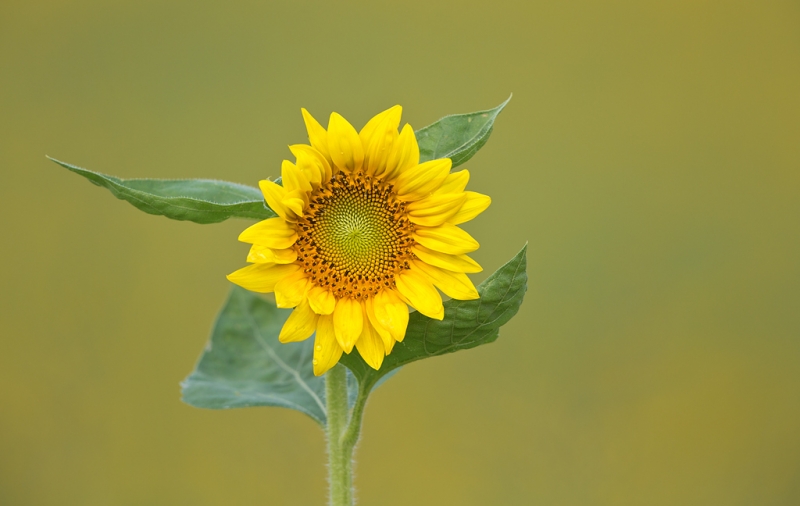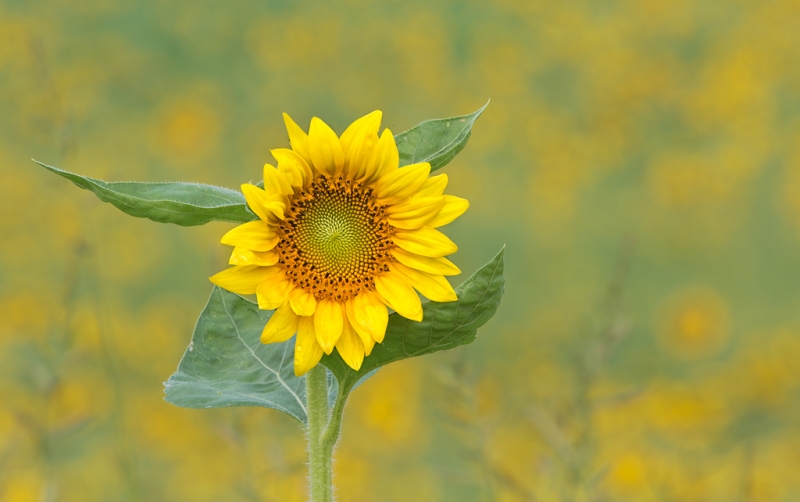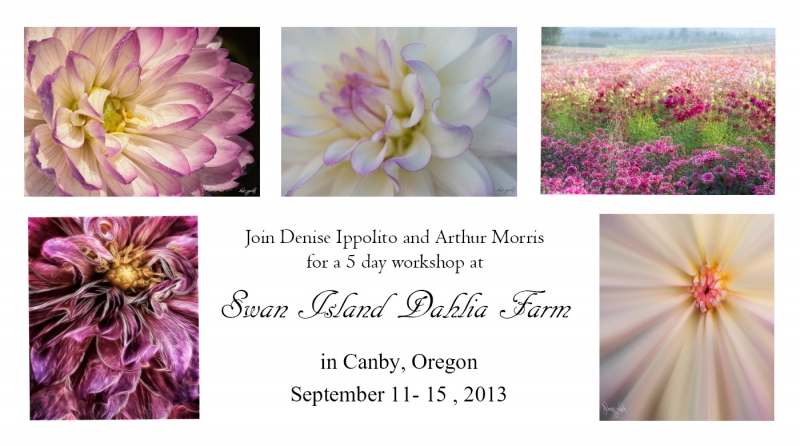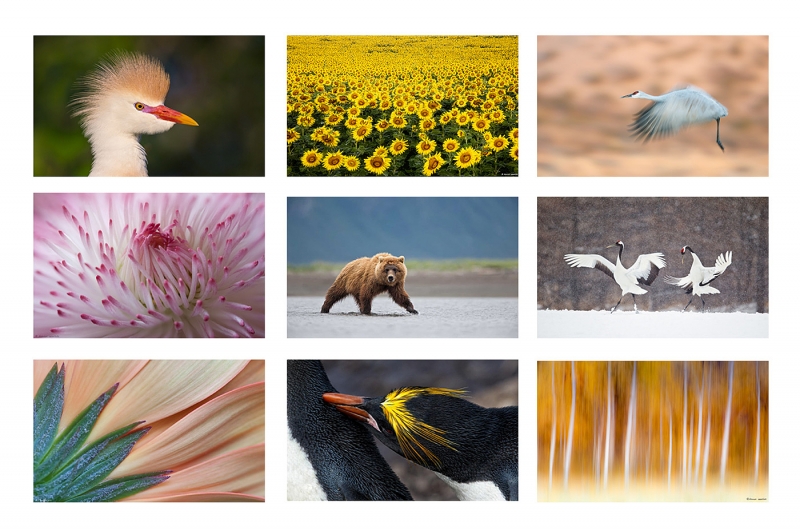|
This sunflower image was created on Denise Ippolito’s A Creative Adventure Sunflower Workshop in Newton, NJ this past August with the tripod-mounted Canon 500mm f/4L EF IS II lens, the Canon 1.4x EF tele-extender III, and the Canon EOS 5D Mark III Digital camera body w/FREE Bonus Item – $91.90 Value! [expires soon]! ISO 400. Evaluative metering +2/3 stop: 1/500 sec. at f/6.3 in Av mode. Central Sensor/AI Servo Rear Focus AF and re-compose. Click here if you missed the Rear Focus Tutorial. Click on the image for a larger version. |
Depth-of-Field Lesson
First off, I love using long glass with teleconverters for large flowers. Why? They offer very narrow angles of view inherently reducing background clutter and they make it easy to isolate single flowers.
The image above was created at f/6.3. Note that f/5.6 would have been wide open. The image below was created at f/32. The first image features a patented BAA background: a swath of nearly pure out-of-focus color. My two favorites for bird photography are still blue water and distant green vegetation, each lit by early morning light on a clear day. There is only a hint of the yellow from the background blossoms.
In the image below the flowers in the background are an integral part of the image, letting the viewer know that the single blossom was not the only sunflower in the field. When framing images like this and working at small apertures it is important to use your camera’s depth-of-field preview to make sure that you have not brought up any unpleasant background detail and that the overall image design is pleasant. Note that since I chose a tall flower as the subject that the blooms in the background are rendered in relatively soft focus even though I was working at f/32.
Just for the record books: the image above had 3 dust bunnies. The image below had about 90 dust spots. At tiny apertures even microscopic dust spots will show up. A bunch of them near the bottom frame-edge might have been tiny flying bugs….
|
This image of the same sunflower was also created with the tripod-mounted Canon 500mm f/4L EF IS II lens, the Canon 1.4x EF tele-extender III, and the Canon EOS 5D Mark III Digital camera body w/FREE Bonus Item – $91.90 Value! [expires soon]! ISO 400. Evaluative metering +2/3 stop: 1/20 sec. at f/32 in Av mode. Central Sensor/AI Servo Rear Focus AF and re-compose. Click here if you missed the Rear Focus Tutorial. Click on the image for a larger version. |
Which Do You Like Best
Take a moment and let us know which of the images above you like best. And why? Which best fits your personal vision and style?
Catching Up
Can You Bear It?
In the “Can You Bear It” post, my two favorites were Fractalius Glow 100 and The Wave, the former for its elegance, the latter for the neat shape.
A New Perspective
In the “A New Perspective” post, I liked the optimized image best as did pretty much everyone who comments. NIK Color Efex Pro really rocked on that image.
It Ain’t Just Birds: Why I Love My Canon EOS-5D Mark III
In the “It Ain’t Just Birds: Why I Love My Canon EOS-5D Mark III” post, I loved all of the images. Aside from smiling Maya, I guess that my very favorite was the HDR Vivid of the pipes and bricks that was created at the old whaling station on Grytviken, South Georgia. I love the colors and the patterns.
|
All images courtesy of and copyright 2012: Denise Ippolito. Click for a larger version. |
A Creative Adventure/BIRDS AS ART Swan Island Dahlia Farm Instructional Photo-Tour, September 11-15, 2013: 5 FULL DAYS: $1649
Join Denise Ippolito and Arthur Morris at the Swan Island Dahlia Farm in Canby Oregon (just south of Portland) for a great learning and photography experience. Swan Island features more than 40 acres with over 350 varieties of dahlias in a plethora of colors, shapes and sizes, making it one of the largest growers in the United States.
For complete details and schedule, click here and see item 1.
BIRDS AS ART/Barnegat Jetty IPT II
BIRDS AS ART/Barnegat Jetty IPT II, Barnegat Light, NJ: 2 1/2 DAYS. JAN 18 (1:30pm), 19, and 20, 2012: $999. Limit 8/Openings: 3. Includes 5 photo-sessions, both lunches, image review, sharing, and editing (JAN 19) & Photoshop session (JAN 20).
Join Denise Ippolito and Arthur Morris for a 2 1/2 Day Instructional Photo-Tour at the infamous Barnegat Jetty in Barnegat Light, New Jersey. You will learn how to get close to the ducks and shorebirds that frequent this famed winter birding and photography hotspot, how to get the right exposure every time, and how to see, understand, and tackle a variety of photographic situations. We should have some excellent chances with Harlequin Duck and Purple Sandpiper, the two headliner species. With any luck we should get to photograph most of these species: Long-tailed Duck (formerly Oldsquaw), Common Loon, Red-throated Loon, Red-breasted Merganser, Surf Scoter, Black Scoter, Common Eider, Brant, Dunlin, Ruddy Turnstone, Black-bellied Plover, and Sanderling. Great Black-backed, Herring, and Ring-billed Gulls are also likely. Sunning Harbor Seals are possible. With the right winds we may have some good flight photography with the sea ducks.
Having at least a 500mm f/4 lens with a 1.4X teleconverter is recommended. Participants should be in good physical condition with a good sense of balance. $500 non-refundable credit card deposit by phone: 1-863-692-0906. Weekends OK. Note: On cloudy days we grab a quick lunch and spend most of the day photographing. 🙂
Weekend Creative Nature Photography Seminar, Tampa, FL: February 23 & 24, 2013: $149 Limit: 50/Openings: 8
Only 8 seats left! Click here for complete details and schedules. Monday In-the-Field Fort DeSoto Workshop and Door Prize info to be announced soon.
Join Denise Ippolito and me on the weekend of February 23-24 on the outskirts of Tampa, FL for a great weekend of fun and learning. Learn to improve your photography skills, your skill at designing images in the field, your creative vision, and your image optimization skills. Sunday critiquing session. Click here for additional details and the complete schedule.
Support the BAA Blog. Support the BAA Bulletins
We want and need to keep providing you with the latest free information, photography and Photoshop lessons, and all manner of related information. Show your appreciation by making your purchases immediately after clicking on any of our B&H (or Amazon.com) Affiliate links in this blog post. Remember, B&H ain’t just photography!


Shop Amazon
And from the BAA On-line Store:
LensCoats. I have a LensCoat on each of my big lenses to protect them from nicks and thus increase their re-sales value. All my big lens LensCoat stuff is in Hardwood Snow pattern.
LegCoat Tripod Leg Covers. I have four tripods active and each has a Hardwood Snow LegCoat on it to help prevent further damage to my tender shoulders 🙂 And you will love them in mega-cold weather….
Gizo GT3532 LS CF Tripod. This one replaces the GT3530LS Tripod and will last you a lifetime. Learn more about this great tripod here.
Mongoose M3.6 Tripod Head. Right now this is the best tripod head around for use with lenses that weigh less than 9 pounds. For heavier lenses, check out the Wimberley V2 head.
Double Bubble Level. You will find one in my camera’s hot shoe whenever I am not using flash.
The Lens Align Mark II. I use the Lens Align Mark II pretty much religiously to micro-adjust all of my gear an average of once a month and always before a major trip. Enjoy our free comprehensive tutorial here.
BreezeBrowser. I do not see how any digital photographer can exist without this program.
Delkin Flash Cards. I use and depend on Delkin compact Flash Cards and card readers most every day. Learn more about their great 700X and 1000X cards here or about my favorite Delkin card here.


















I’m a little late to these comments, but this is the first time I’ve seen them. Some like f6.3 – very shallow depth of field, some like f32 – maximum depth of field (for a single capture). I think I would have liked it somewhere around f16 or so, the best of both worlds …
Fields of sunflowers can be captured a million different ways. They are such photo candy stores.
Hi Arthur,
It ain’t just birds! 🙂 Yes, i prefer the 2nd one also as the background provides context for the main subject without distracting too much attention away from it – it’s complementary. The distant out of focus sunflowers provide an added layer of interest to the image, which make the 1st image seem somewhat dull/ lifeless by comparison.
“One or Many?” Well it seems you can have “both”!! 🙂
Gosh! I thought I’d write something because there were only 6 comments showing, but that just jumped to 25! Guess I really shouldn’t leave pages open in Mozilla for reading later without refreshing them first!! 😀
This is really a study in bokeh, isn’t it?
Going by the strictest interpretation of the definition below, adapted from Wikipedia, I would have to say “No.”
In photography, bokeh is the aesthetic quality of the blur in out-of-focus areas of an image. Bokeh has been defined as “the way the lens renders out-of-focus points of light”. However, differences in lens aberrations and aperture shape cause some lens designs to blur the image in a way that is pleasing to the eye, while others produce blurring that is unpleasant or distracting—”good” and “bad” bokeh, respectively. Bokeh occurs for parts of the scene that lie outside the depth of field. Photographers sometimes deliberately use a shallow focus technique to create images with prominent out-of-focus regions. Bokeh is often most visible around small background highlights, such as specular reflections and light sources, which is why it is often associated with such areas.[3] However, bokeh is not limited to highlights; blur occurs in all out-of-focus regions of the image.
See more here.
I guess that one might say that both of the images exhibit good bokeh.
Not sure what the quality would be, but I think it would
be interesting to see a crop of just the inside of the
sunflower…getting an extreme closeup.
Doug
Keith: I was thinking the same and wondering why. The second image has additional flowers in the background, flowers like the main subject. Imagine a bird–say a penguin or a gannet–with lots of OOF blurry birds of the same species in the background. I can see that being good–I wouldn’t be surprised if Artie has such images–and I think that would be good. An unrelated background not so much.
Second one, by a country mile.
The first is rather boring, and the subject isn’t interesting enough in itself to “carry” the (almost literally) monotonous BG. I completely “get” that kind of BG for birds, but it doesn’t do anything for this subject matter.
It’s clearly #2 for me, I agree that #1 appears somewhat sterile, while the blurry background in #2 adds an element of softness to the image.
Glad you showed both… After seeing the 2nd shot, I decided I likes it better. The first one seems almost too sterile for me, like it could have been shot with a green board background. The second one shows the context of the shot and tells the story behind it. Beautiful shot!
Art, this is very interesting, because I find myself asking the questions – “What if I had seen the second image without having seen the first one? Would I like it?” The answer is yes, but having seen the first one, I must say that I prefer it to the second one, probably because of the smoother, more blurred, background. I suspect that if the background in the second one had been anything but a mix of blurred green and yellow, then the results might have been different – just speculating. Either image is great IMHO, I guess it all depends on what floats your boat, so to speak.
Hi Artie. I think both have their merits, and I like them equally. I’m also a fan of nice smooth backgrounds.
Cheers,
Denny
Call me crazy but I’d like to see the second sunflower and leaves in focus with the background closer to the blur of the first one.
Much prefer #2. For me, the completely blurred forground/background entirely removes the context of the subject from the image. With the right lens and light, anyone can get all the blurry stuff, but so what. Put your subject in an environment, and for me it’s very pleasing. Take the environment away by blurring it, and IMO you might just as well have taken an image of the subject in a cage. Just my opinion.
I guess that I should have been working in Burger King for the past two decades as the clean background look is my signature style. I have, however, done fairly well with birds against those super-clearn blurred BKGRs. So what? That’s what :).
By far the #2 for me. The background of out of focus flowers reinforce the main subject.
I’ll choose door #2, Monty!
I love the subtle suggestion of the flowers in the background; they add a really beautiful context for the image. There is a branch, or twig, or something that almost looks like a tripod on the bottom left side of the image. I’m sure you didn’t put your tripod in the picture 😉 but it’s a little distracting.
I never noticed that until you mentioned it. It’s a Gitzo Model 3541L!
The “tripod” is actually two sunflower stalks. After stopped down viewing I chose my perspective so that they and the single stalk to the right of the subject formed something of a frame. I do not find either at all distracting. In fact, I think that they add to the image.
I like both – but (surprising to myself) I like #2 better. I’ve always been a fan of solid blurry backgrounds, however in this case it works perfectly because there are so many other sunflowers behind it and they are soft enough to provide some color without clutter. If there had been a car, a fence, or other junk then #1 would have been MUCH better.
thanks for sharing
Charles
Hi, Artie, and thanks as always. Your images confirm two other lessons for me. First is that even at very small apertures, the depth of field with a long lens remains very small. I find that even with my 400 F/5.6L “toy lens,” which fortunately is very sharp at full aperture, I usually stop down only to change exposure, not for depth of field. Going even to f/11 doesn’t get me much extra depth of field. (And of course I can’t handhold it and shoot flying birds at f/32.) But you’ve shown beautifully that even a subtle difference can be very important. The second lesson is that the constant chatter I hear about “diffraction effects” at small apertures is just that, chatter. I can’t see any evidence of it in your images. I like them both a lot but prefer the second for the reasons you and other posters have given.
Thanks for the lesson. I get so accustomed to minimizing backgrounds with long shots it’s easy to forget their potential.
It may be an illusion but the flower in #2 appears brighter than in #1 – however, I love the simplicity of the first image. It draws my attention to the flower and I want to know more about just the flower.
Thanks Jim, The RGB #s on each flower are pretty much the same as far as I can tell. The green leaf below and to our right of the flower, however, is well darker in the opening image…. Not sure why but that can certainly influence how we perceive the tonality of the flower.
Good lesson on depth of field with long lenses. Thanks.
I prefer image 2. I find the out of focus back green leaf in the first image distracting. I also think that the out of focus flowers in the background of image 2 give it some context.
Artie
#2 for me It is more meaningful. No 1 is just a static flower image